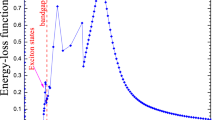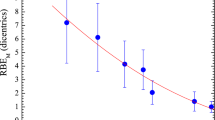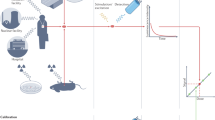Abstract
IN a previous paper1 we quoted a number of results appearing in the literature which demonstrate quantitative relationships between the dose of protective agent and radiation dose. This applies especially to sulphydryl substances. In assuming that the sulphydryl protective agents act as radical scavengers this can be easily understood. Higher radiation doses may produce higher concentrations of radicals in the tissue and for this reason the concentration of radical scavengers must also be higher. Contrary to this, high radical scavenger doses may have relatively less protective effect in lower radiation doses. The increase rate of the protective effect of such agents is larger for higher radiation doses than for lower ones.
This is a preview of subscription content, access via your institution
Access options
Subscribe to this journal
Receive 51 print issues and online access
$199.00 per year
only $3.90 per issue
Buy this article
- Purchase on Springer Link
- Instant access to full article PDF
Prices may be subject to local taxes which are calculated during checkout
Similar content being viewed by others
References
Koch, R., and Langendorff, M., Strahlentherapie, 120, 269 (1963).
Koch, R., Strahlentherapie, Sdb., 51, 224 (1962).
van der Meer, C., and van Bekkum, D. W., Intern. J. Rad. Biol., 1, 5 (1959).
Author information
Authors and Affiliations
Rights and permissions
About this article
Cite this article
KOCH, R., SEITER, I. Quantitative Relations between Doses of Chemical Protective Agents and Doses of X-irradiation. Nature 203, 984–985 (1964). https://doi.org/10.1038/203984a0
Published:
Issue Date:
DOI: https://doi.org/10.1038/203984a0
Comments
By submitting a comment you agree to abide by our Terms and Community Guidelines. If you find something abusive or that does not comply with our terms or guidelines please flag it as inappropriate.



